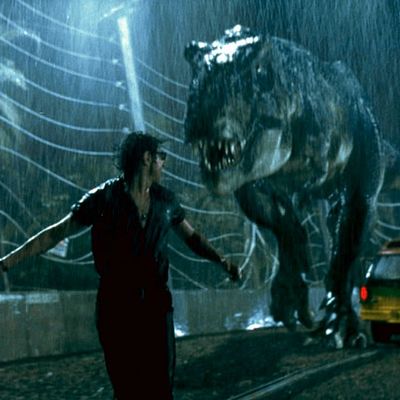
Like a mosquito trapped in amber, Jurassic Park has held up remarkably well, and itÔÇÖs got some pretty influential DNA. Jurassic Park was a pivot point for modern summer blockbusters, and though many special-effects-laden movies have followed in its earth-shaking footprints, few have pulled it off with the same panache as Steven Spielberg did in 1993. With the 3-D rerelease of Jurassic coming out this Friday, then, what better time to don a neck kerchief, brandish a brush, and go full-paleontologist on the bones of this action classic to study what it did right and what modern blockbusters could learn from it?
Not every effect should be created in a computer.
Jurassic Park helped to pioneer the use of computer-generated imagery twenty years ago  and nearly all of it still looks impeccable. How is it possible that the effects in this movie have aged better than some of the clearly fake CGI we get served in 2013? In part, thats because Spielberg used the technique so sparingly: Whenever possible, he had Stan Winston create the dinosaurs through practical effects, then seamlessly blended in CGI shots only when there were moments that simply couldnt be attained any other way. The T. rex attack sequence is so scary because you can practically feel the enormous weight and the tactile mass of the model dinosaur Winston built; later, when there are a few stray shots of the computer-generated T. rex chasing a Jeep, weve instinctively accepted the reality of this character in a way we wouldnt have if the tyrannosaur had been a CGI creation the whole time. Yes, computer-generated imagery has become pretty sophisticated in the last twenty years, but our brains can still tell the difference.
A recognizable theme pays dividends.
The Jurassic Park score is simply iconic, and itÔÇÖs hard to believe that John Williams wasnÔÇÖt even Oscar-nominated for it (admittedly, he won that year for his work on SchindlerÔÇÖs List, but still!). More than just a wonderful mood-setter ÔÇö try not to get goosebumps when the main theme plays for the first time in Jurassic Park 3D ÔÇö itÔÇÖs memorable in a way that so few summer movie scores are nowadays. Sure, those window-shaking BRAAAAMs in Inception were a big deal, but can you hum them? Yes, The Avengers was a fun pop spectacle, but can you recall the music at all? You only have to listen to a few notes of the Jurassic Park theme for the whole movie to come back to you in a giddy rush, and thatÔÇÖs the sign of real movie magic.
An action movie benefits from some quiet.
Still, John Williams knew when to get out of the way: That T. rex attack sequence is silent but for the roars, screams, and drizzle. In fact, Spielberg follows up almost every big action scene with a low-key moment of reflection, a welcome relief from modern-day action movies that never stop the onslaught so you can get your bearings.
You donÔÇÖt always have to cast movie stars.
Spielberg could have gotten almost anybody to play the two leads in Jurassic Park  and yet he cast Sam Neill, a jobbing 46-year-old actor from New Zealand, and Laura Dern, a young actress better known for daring David Lynch movies than dinosaur blockbusters. (Spielbergs original choice for Derns role was even more unlikely: French actress Juliette Binoche, three years before she made The English Patient.) Admittedly, the dinosaurs were a bigger draw than any of the humans in this movie  and the critical rap against Jurassic Park at the time was that its human characters were underdeveloped  but Neill, Dern, and Jeff Goldblum are better than you remember, bringing lived-in eccentricity to every line reading.
DonÔÇÖt forget the sense of wonder.
Spielberg takes a lot of flak for all those close-ups where his characters stare in awe, mouths agape, but never was it more warranted than in Jurassic Park. These people are staring at freakinÔÇÖ dinosaurs ÔǪ of course theyÔÇÖre going to fall to their knees and open their eyes wide! And frankly, movies need that sense of wonder: Too many of todayÔÇÖs action blockbusters give us fantastical action scenes the likes weÔÇÖve never seen before, but the characters take them in stride, depriving the audience of the opportunity to gape alongside them. Yes, The Avengers had a memorably epic third-act action sequence, but when the characters act so┬áblas├® about the enormous alien invasion bringing down New York City around them, does that sense of scale truly sink in? Subtract those Spielberg faces, and even he can misstep: Indiana Jones was a terrific hero through three movies precisely because he was so vulnerable and awestruck, but in the most recent installment, Indiana Jones and the Kingdom of the Crystal Skull, he blithely survived fridge-nuking and waterfall plummets and acted like it was just another day at the job. Jurassic Park may have a lot to teach modern blockbusters, but if thereÔÇÖs one lesson Spielberg himself could afford to relearn, itÔÇÖs this one.

